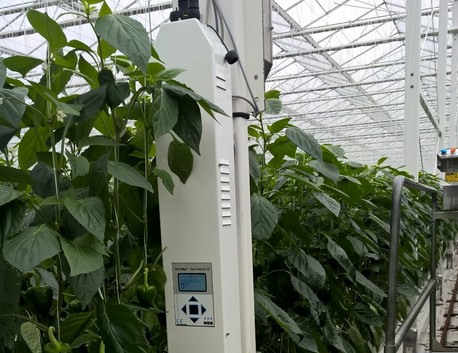Whileusing CO2 fertilization in greenhouses, there is a possibility of amassment orpile up of harmful gas. The reason for this pile up is that CO2 is consumed by thecrop, and harmful gas is not immediately broken down. A small amount of(harmful) gas which is present in the greenhouse for a relative short period oftime, would (normally)not be detrimental to the crop. However, exposing the crop to a minimum of gasfor a relatively long period of time could damage the crop. This is alsodependent on the kindof crop, cultivar, age and improving stress conditions like light, temperature,RH etc. around the crop.
The tool installed at Tangmere Airfield Nurseries is the MACView Gas Analyzer from Dutch environmental monitoring controls company EMS. This instrument can be hung among the crops in the greenhouse and it will monitor the levels of gases present. It is able to measure the levels of CO, CO2, Ethylene, NO and NO2. Every 15 minutes a measurement is made and the Gas Analyzer will push the data and analysis towards the grower's computer.
Vonk rented the machine from manufacturer EMS and placed it at several locations in their 30 hectare greenhouse operation. "We have three separate greenhouses which are all connected to each other with one central heating system. The greenhouses are primarily heated with heat from three 2.7 MW CHPs. We also have natural gas boilers as a backup for the colder months. The CO2 that we use, mostly comes from the cogeneration."

The MACView-Greenhouse Gas Analyzer is an extremely sensitive gas measurement device for monitoring harmful gases in greenhouses. The gas measurement
device measures NO, NO2, C2H4, CO and CO2 in ambient air with very high precision. The MACView-Greenhouse GA displays the amount of gas in the
range of ppb (Parts Per Billion). This device assists the grower in becoming more conscious and gives more insight into the amount of harmful gas around the crop.
The allowable concentrations and time for crops are known as maximum allowed concentrations over time.
The grower installed the Gas Analyzer primarily in order to have a clear overview of the gases inside the greenhouses after the installation of their new cogeneration system. "Having cogens running for heat and CO2 is not without risk. While flue gas cleaners are used, you still cannot be careful enough in our opinion."
The grower plans to continue the measurements. "We believe that much better results can be achieved when you can measure what you are doing. Thanks to the Analyzer we can see what kind of levels are present in the greenhouse, and we are able to optimize the growth even better. The analyzer makes us more aware and can prevent losses when there are certain harmful gases inside the greenhouse environment; the system allows you to undertake action in time."
What is measured?
- NO(Nitric Oxide):This type of gas is emitted during combustion processes most of the time. Theseprocesses could be: engines (cogeneration), boilers,stoves, fire, vans/cars. Crop can handle a certain amount of NO. Abovethat amount, NO becomes toxic for thecrop. It will cost the plant energy to break down the toxins. In short: Photosynthesisdecreases.
- NO2(Nitrogen Dioxide):NO2 is often produced as a result of incomplete combustion. Crops can handle acertain amount of NO2. Abovethat amount, NO2 also becomes toxic for the crop. In short: Photosynthesisdecreases again.
- C2H4(Ethylene or Ethene):Like NO and NO2, Ethylene is also emitted during (incomplete) combustionprocesses. Ethylene is a well-knownplant hormone. Unlike the previous gases, ethylene is also produced innature. The crop is capable of producing a little amountof ethylene. In practice, these little amounts aren’t enough to make a clearmeasurement. Ethylene at higher levels can causepremature senescence, flower abortion and unwanted coloring of leaves.
- CO(Carbon monoxide):Normally CO isn’t that bad for plants. However, where NO, NO2 and ethylene areproduced during combustion processes, there’salso most of the time CO available which causes incomplete combustion. Withthis parameter it would be possible todetect the reason of air pollution in greenhouses.
- CO2(Carbon dioxide):In contrast to NOx, ethylene and CO, CO2 is a desirable component to fertilizethe crop. So the ratio between harmfulgas components and CO2 is important.
EMS B.V.
+31 (0)166 657200
[email protected]
www.macview.nl










